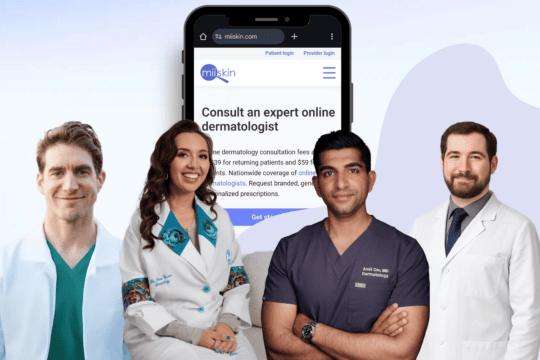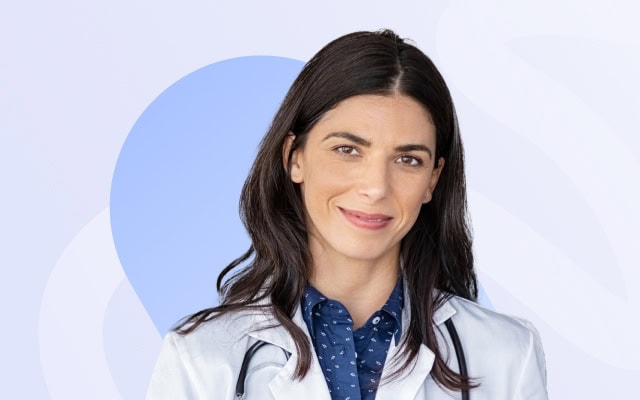The best apps for online dermatology consultations: 7 options compared
This article gives you a comparison between 7 dermatology apps for online consultations, and explains why the Miiskin app stands out as the best alternative.
Table of Content:
Why is Miiskin the best app for online consultations? | Miiskin | FirstDerm | RealSelf | SkyMD | Teladoc | iDoc24 | DermatologistOnCall
Our commitment to producing high-quality content:
The information presented in this article is based on scientific research and the professional advice of our Content Medical Reviewers, who are experts in the field of Dermatology. How we write our content →
In today’s digital healthcare landscape, dermatology apps have become a convenient and effective way for people to get expert skin care without stepping into a clinic. With a growing number of platforms offering everything from AI-powered mole scans to anonymous consultations and full-service telehealth, choosing the right dermatology app can feel overwhelming. Each app caters to different needs—some prioritize speed, others affordability, and a few focus exclusively on cosmetic procedures. However, when it comes to combining clinical quality, access to personalized prescriptions, and ease of use, one app consistently stands out from the rest: Miiskin.
Miiskin has carved out a unique position in the dermatology app market by offering accessible, affordable, and medically robust virtual care.
Why is Miiskin one of the best Dermatology Apps?
Miiskin stands out as one of the most well-rounded and accessible dermatology app because it strikes the ideal balance between affordability, clinical depth, and prescription capabilities.
Unlike anonymous platforms like First Derm or iDoc24, who cannot issue prescriptions, Miiskin offers full medical consultations with board-certified dermatologists who offer treatment, including personalized prescriptions for conditions like acne, melasma, and hair loss, without locking them in a medication subscription.
Compared to services like Teladoc or SkyMD, the consultations offered via the Miiskin app are more affordable (at $39–$59 per consultation vs. $89–$99), while still offering high-quality care.
It also avoids the higher, cosmetic-focused pricing of RealSelf, and unlike DermatologistOnCall, Miiskin has a dedicated app for both iOS and Android, making it more accessible and user-friendly for patients across all 50 states.
Overall, Miiskin delivers a specialized dermatology experience that is cost-effective, prescription-capable, and easy to use—without requiring a subscription or insurance.
List of Dermatology apps for virtual care
1. Miiskin
- Purpose: Online dermatology consultations.
- Features: Connects users with board-certified dermatologists across all 50 U.S. states. Patients can receive personalized prescriptions for conditions such as acne, rosacea, melasma, hair loss, and anti-aging concerns.
- Availability: iOS and Android
- Consultation Price: $39 – $59
- Prescriptions: Yes – Dermatologists can prescribe medications (including compounded ones) after verifying patient identity.
2. First Derm
- Purpose: Anonymous dermatology consultations.
- Features: Users submit photos and descriptions of skin concerns anonymously and receive feedback from board-certified dermatologists within varying response times.
- Availability: iOS, Android, and web
- Consultation Price: $34.95 – $69.99
- Prescriptions: No – Due to its anonymous nature, First Derm cannot provide prescriptions.
3. RealSelf
- Purpose: Cosmetic treatment reviews and consultations.
- Features: Lets users research aesthetic treatments, read reviews, and connect with certified providers for procedures like Botox, fillers, and laser treatments.
- Availability: iOS and web
- Consultation Price: $100 – $250
- Prescriptions: No – since it is a service to evaluate in-person treatments
4. SkyMD
- Purpose: Online consultations for multiple health concerns
- Features: Provides diagnosis and treatment for a wide range of skin, hair, and nail conditions through video consultations with board-certified dermatologists.
- Availability: iOS, Android, and web
- Consultation Price: $99
- Prescriptions: Yes – Dermatologists can prescribe medications after proper consultation and verification.
5. Teladoc Health
- Purpose: Online consultations for multiple health concerns
- Features: Offers virtual consultations with U.S. board-certified dermatologists for various skin issues (e.g., acne, eczema, psoriasis).
- Availability: iOS, Android, and web
- Consultation Price: $89
- Prescriptions: Yes – Licensed dermatologists can prescribe medications following the consultation.
6. iDoc24
- Purpose: Anonymous dermatology consultations.
- Features: Provides quick evaluations of skin issues by board-certified dermatologists to help determine the need for further in-person evaluation.
- Availability: iOS and Android
- Consultation Price: $34.95
- Prescriptions: No – due to its anonymous nature healthcare providers cannot prescribe any medications.
7. DermatologistOnCall
- Purpose: Asynchronous dermatology consultations.
- Features: Allows users to submit images and details about skin concerns at any time; board-certified dermatologists review cases and respond within 48 hours.
- Availability: Web-based platform
- Consultation Price: $95 per consultation
- Prescriptions: Yes – Licensed dermatologists can prescribe medications as appropriate following their review and patient verification.
Conclusion
Choosing the right dermatology app depends on your needs—whether you’re looking for fast advice, affordable care, or access to prescription treatments. While each of the seven apps listed has its strengths, Miiskin stands out for offering the most complete package: affordable consultations, nationwide access, and the ability to prescribe both standard and compounded medications for a range of skin and hair conditions. Whether you’re managing acne, melasma, or hair loss, Miiskin delivers expert care directly to your phone without the need for insurance or lengthy wait times. As digital health continues to evolve, platforms like
Interested in learning more about telehealth companies?
Apostrophe skincare alternative
How to get a prescription through an online compounding pharmacy?
Hers vs Miiskin for anti-aging and hair loss
Get hair loss treatment with this app
The best online services for customized prescription skincare
Online vs in-person dermatology: How Miiskin delivers truly personalized online care



 Need a dermatologist appointment?
Need a dermatologist appointment?
